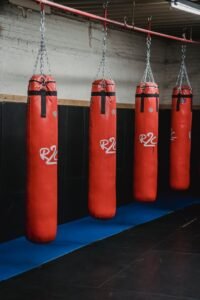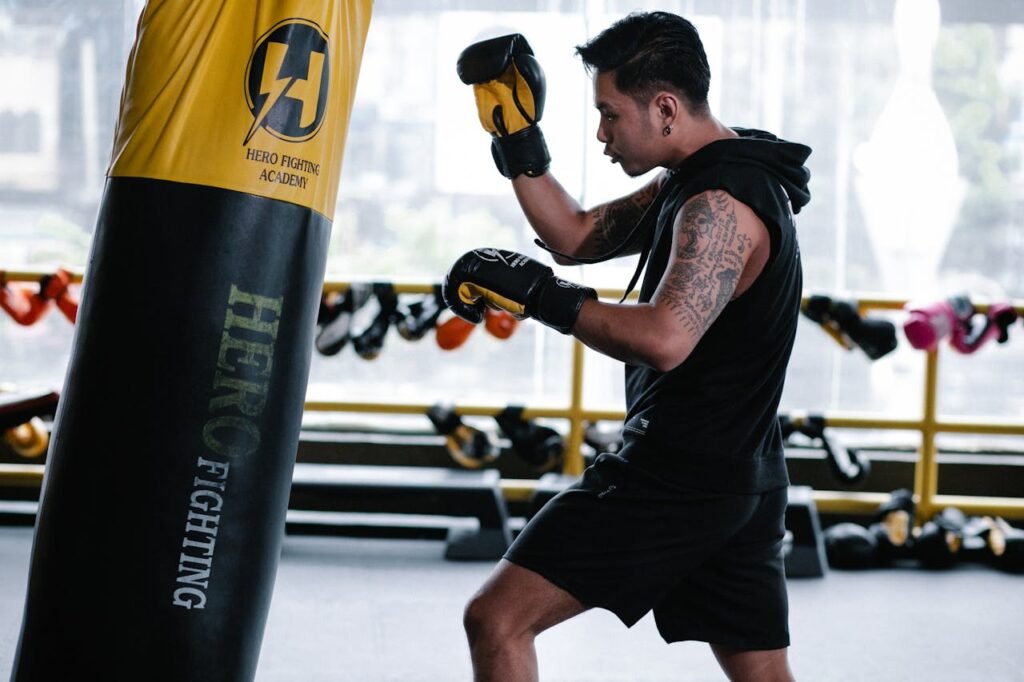While I was looking for information about boxing bags, I started with very basic queries and I had lots of questions at that time. Later on, I sourced the answer to all my queries and here it is. You can call Boxing bags or punching bags, as people are using to both of them. This bag is really essential tool for anyone looking to improve their fitness, boxing skills, or stress relief.
From classic heavy bags to innovative reflex balls, these bags come in various types, each serving a different purpose. Here I have break down the different types of boxing bags, explained how to use them, and explored the many benefits they offer.
I have identified the types of boxing bag, and gave small description with common sizes, what it best for with some example.
Types of Boxing Bags
1. Heavy Bag
Description: The heavy bag is the most traditional type of boxing bag. It is large, cylindrical, and filled with materials like sand, sawdust, or fabric scraps.
Common Sizes: Typically ranges from 40 to 70 pounds and 4 to 6 feet in length.
Best For: Power punching, full-body workouts, and developing endurance.
Examples:
- Everlast Heavy Bag: Made from synthetic leather with a heavy-duty chain for hanging.
- Ringside Elite Heavy Bag: Features durable vinyl construction and reinforced seams.
How to Use:
- Warm-Up: Start with basic jabs and crosses to get your body warmed up.
- Techniques: Practice combinations like jab-cross, hooks, and uppercuts.
- Footwork: Move around the bag to work on your footwork and balance.
- Endurance: Incorporate intervals of high-intensity punching followed by rest periods.
Benefits:
- Builds punching power and technique.
- Enhances cardiovascular endurance.
- Improves overall strength and conditioning.
- Great for stress relief.

2. Speed Bag
Description: The speed bag is a smaller, teardrop-shaped bag mounted on a swivel platform. It is designed to bounce back quickly when struck.
Common Sizes: Generally 8 to 12 inches in diameter.
Best For: Hand speed, coordination, and reflexes.
Examples:
- Everlast Speed Bag: Constructed with high-quality leather for durability.
- Title Boxing Speed Bag: Features a rubber bladder and reinforced seams.
How to Use:
- Warm-Up: Start with light taps to get the bag moving.
- Techniques: Focus on rhythm and speed, using both hands alternately.
- Rhythm: Work on maintaining a consistent rhythm and increasing speed over time.
- Reflexes: Try to hit the bag as it rebounds back to you, improving your hand-eye coordination.
Benefits:
- Improves hand speed and reflexes.
- Enhances hand-eye coordination.
- Develops timing and rhythm in punches.
- Great for fine-tuning techniques.
3. Double-End Bag
Description: The double-end bag is a smaller bag attached to two elastic cords. It moves back and forth when struck.
Common Sizes: Typically 6 to 8 inches in diameter.
Best For: Accuracy, defensive skills, and reflex training.
Examples:
- Everlast Double-End Bag: Features an adjustable tension system and durable construction.
- Ringside Double-End Bag: Comes with a set of adjustable cords and a sturdy design.
How to Use:
- Warm-Up: Start with gentle jabs to get a feel for the bag’s movement.
- Techniques: Work on punches, slips, and counter-attacks.
- Accuracy: Focus on hitting the target area accurately as the bag rebounds.
- Defensive Skills: Incorporate defensive moves like slipping and weaving.
Benefits:
- Enhances punching accuracy.
- Improves defensive techniques and reflexes.
- Develops timing and precision.
- Great for advanced training and technique improvement.

4. Body Bag
Description: The body bag is designed to simulate a human opponent. It has a torso shape and is filled with materials for a realistic training experience.
Common Sizes: Usually around 5 to 6 feet in height.
Best For: Body shots, combination drills, and realistic training scenarios.
Examples:
- Title Boxing Body Opponent Bag: Features a realistic body shape and adjustable height.
- Everlast Body Bag: Made from synthetic leather with a realistic design.
How to Use:
- Warm-Up: Begin with light punches and body shots.
- Techniques: Practice body combinations and simulate fight scenarios.
- Realism: Use the bag for drills that mimic real-life fighting situations.
- Variety: Incorporate various techniques like hooks to the body and uppercuts.
Benefits:
- Provides a realistic training experience.
- Focuses on body shots and combination drills.
- Great for simulating real fight conditions.
- Improves overall fighting technique.
5. Reflex Bag
Description: The reflex bag is a small, ball-like bag mounted on a flexible, adjustable stand. It moves unpredictably when struck.
Common Sizes: About 6 to 8 inches in diameter.
Best For: Speed, reflexes, and hand-eye coordination.
Examples:
- Everlast Reflex Bag: Features a sturdy base and adjustable height.
- Ringside Reflex Bag: Comes with a durable ball and flexible stand.
How to Use:
- Warm-Up: Start with slow, controlled punches.
- Techniques: Focus on quick, accurate strikes as the bag rebounds.
- Reflexes: Work on reacting quickly to the bag’s movements.
- Speed: Try to increase your striking speed and accuracy.
Benefits:
- Improves hand speed and reflexes.
- Enhances hand-eye coordination.
- Develops quick reaction times.
- Great for speed and agility training.

6. Aqua Bag
Description: The aqua bag is filled with water instead of traditional materials. The water shifts inside, creating a dynamic training experience.
Common Sizes: Varies, but typically around 50 to 70 pounds.
Best For: Developing punching technique and handling shifting weight.
Examples:
- Aqua Bag Heavy Bag: Features a water-filled interior and durable construction.
- ProForm Aqua Bag: Comes with adjustable water levels and a sturdy design.
How to Use:
- Warm-Up: Begin with basic strikes to get used to the shifting weight.
- Techniques: Practice various punches and combinations.
- Adjustment: Vary the water level for different training intensities.
- Balance: Focus on maintaining balance and adapting to the shifting weight.
Benefits:
- Offers a unique training experience with shifting weight.
- Improves balance and core strength.
- Great for developing proper punching technique.
- Versatile and adjustable for different workout intensities.
Benefits of Using Boxing Bags
Alright, I hope you have got the types of boxing bag, lets lean about the benefit of using it.
1. Cardiovascular Fitness
Boxing bags provide an excellent cardiovascular workout. Regular use helps to increase heart rate, improve endurance, and boost overall cardiovascular health.
2. Strength and Conditioning
Hitting a heavy bag builds upper body strength, enhances core stability, and conditions your muscles. It also works your legs, arms, and core, providing a full-body workout.
3. Skill Development
Different types of bags are designed to improve specific boxing skills. Heavy bags are great for power and endurance, while speed bags enhance hand speed and coordination.
4. Stress Relief
The physical activity of hitting a bag can be a great outlet for stress. It provides a healthy way to channel frustration and anxiety, leaving you feeling more relaxed.
5. Improved Coordination
Boxing bags help develop hand-eye coordination, timing, and reflexes. Techniques practiced on a speed bag or reflex bag enhance your ability to react quickly and accurately.
6. Weight Management
Consistent boxing bag workouts help burn calories and manage weight. High-intensity training sessions can effectively contribute to weight loss and maintenance.
7. Discipline and Focus
Training with a boxing bag requires focus and discipline. Regular practice helps develop a strong work ethic and mental toughness, valuable traits both in and out of the gym.
8. Self-Defense Skills
Training with boxing bags helps develop self-defense techniques. Although it’s not a substitute for formal self-defense classes, it builds basic skills and confidence.
Boxing bags are versatile training tools that cater to various fitness levels and goals. From the classic heavy bag for power and endurance to the reflex bag for speed and coordination, there’s a boxing bag suited for everyone. Understanding the different types of boxing bags, how to use them, and their benefits can help you get the most out of your workouts.
Whether you’re a beginner looking to get fit or a seasoned fighter refining your skills, incorporating boxing bag workouts into your routine can lead to significant physical and mental benefits. So, choose the right bag for your needs, follow the proper techniques, and enjoy the journey to better fitness and fighting prowess.

